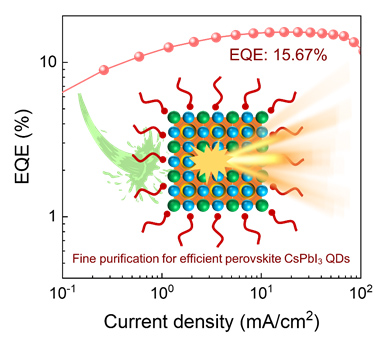摘要/Abstract

钙钛矿量子点发光二极管(QLEDs)因其色纯度高、颜色控制精准、色域广以及溶液可加工等特点, 在显示和照明等领域有着极大的应用前景. 针对红光钙钛矿CsPbI3量子点纯化过程中相变和表面配体损失造成的荧光退化问题, 本工作发展了一种甲苯和乙酸乙酯协同的混合溶剂纯化策略, 能够避免纯化过程中的相变问题, 获得了纯立方相的CsPbI3量子点; 此外, 进一步提出了油胺碘(OAmI)调控量子点表面态的配体补偿工艺, 解决了配体损失导致的荧光淬灭问题, 发现在引入400 μL的OAmI时, 量子点兼具高的发光效率(PLQY为70%)和优异的电学性能, 电驱动下的激子复合几率显著增加, 最终实现了亮度为3090 cd/m 2和外量子效率为15.67%的QLED. 这种钙钛矿CsPbI3量子点精细纯化的方案对开发高效量子点材料和实现高性能光电子器件具有重要的指导意义.
关键词: 无机钙钛矿量子点, 纯化, 配体补偿, 量子点发光二极管, CsPbI3
Perovskite quantum dot light-emitting diodes (QLEDs) possess the characteristics of high color purity, precise color control, wide gamut, and solution processibility, which shows great prospects in displays and lightings. However, red CsPbI3 quantum dots (QDs) are prone to luminescence degradation due to the thermal non-equilibrium-induced phase transition and ligand loss during the purification process. The purification of CsPbI3 QDs is more difficult than that of CsPbBr3 QDs. Because the ligands on the surface of the quantum dots will be lost continuously during the purification process, resulting in aggregation and transformation toδ-CsPbI3 phase. Aiming at this problem, We prepared the CsPbI3 QDs through a hot-injection method at 180 ℃. The original solution of the perovskite QD also contains impurities such as octadecene solvent, oleic amine, and oleic acid ligand, which will seriously affect the photoelectric properties and destroy the film. So we used different flocculation solvents and dispersion solvents to collaboratively purify the QDs. At last, our work developed a mixed-solvent purification strategy with toluene and ethyl acetate, which can avoid the phase transition during the purification process and lead to pure cubic CsPbI3 QDs. But when we do not add the additional ligands in purification process, the photoluminescence quantum yield (PLQY) of QDs will be far less than 100%. In order to enhance the PLQY, a ligand compensation strategy of using oleylammonium iodide (OAmI) to control the surface state of QDs was proposed, which reduced the surface defects and solved the problem of luminescence quenching caused by ligand loss. We found that 400 μL OAmI enabled quantum dots to have both high PLQY of 70% and excellent electrical properties. Under electrically driven, the exciton recombination probability was significantly increased, and the CsPbI3- based QLED achieved a maximum luminance of 3090 cd/m2 and a maximum external quantum efficiency (EQE) of 15.67%. The proposed fine purification strategy of CsPbI3 QDs has an important guiding significance for the development of high-efficiency QD materials and high-performance optoelectronic devices.
Key words: inorganic perovskite quantum dot, purification, ligand compensation, quantum dot light-emitting diodes (QLEDs), CsPbI3
PDF全文下载地址:
点我下载PDF
